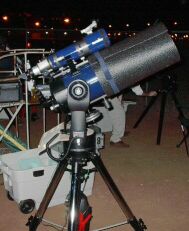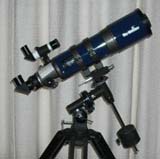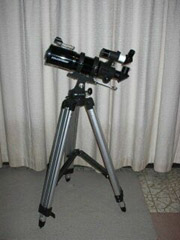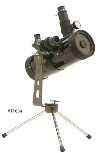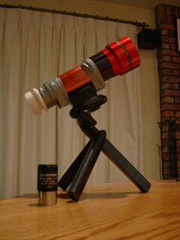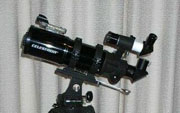| Here is my small collection of scopes. Although I've only started using telescopes recently, I've turned into a bit of an equipment freak. I like to experiment with scopes and equipment, too. Please don't laugh at the two smallest scopes - they both work surprisingly well! | |||||||||||
| LX-90 | Orion Skyquest XT8 | SkyWatcher 102 | Celestron FS80WA | ||||||||
| Finders | . | Celestron TT76 | "Red Neck" | ||||||||
Meade LX-90
I've found this to be a scope with great optics and features. It's small enough to move easily and large enough to gather great views. The tension springs on the sides make it very stable, yet easy to point. I use this scope for my serious observing. Click here to learn how to manually add a satellite to the Autostar. |
|
||||||||||
Orion SkyQuest XT8
I've found this to be a scope with great optics and features. It's small enough to move easily and large enough to gather great views. The tension springs on the sides make it very stable, yet easy to point. I use this scope for my serious observing. |
|||||||||||
SkyWatcher 102
This scope is the big-brother of the Celestron FS80wa and is an excellent wide-field scope. This scope is the scope I'm most likely to use for a quick view, solar observing, while traveling. The real beauty of this scope is in wide views - a 30mm eyepiece gives you 3° FOV! Open clusters, star clouds, and brighter deep sky objects are great targets for this capable scope. |
|||||||||||
Celestron FirstScope 80wa
This was the scope that sold me on rich-field refractors and portable scopes. It is true - you use the scope that's the most handy. After only a few uses, I knew that a short focal length scope would always be in my arsenal. My only complaint about the FS80 was the small aperture, so I purchased the SkyWatcher 102. I now use it as a super finder and rich field scope mounted on the LX90. |
|||||||||||
Celestron Tabletop 76
I bought this on a whim, as a "toy" and found that is actually was a capable little scope. Its small aperture and large central obstruction mean that this is not a good scope for faint objects, but it's fantastic for an ultra portable solar scope. I get a quick lunch-time "fix" by popping down to my truck and look for sun spots. |
Several astronomy club members threatened to use it for a finder, while others immediately named it "mini-me." This little scope has earned a (small) place in my heart just for the fun factor involved. |
||||||||||
"Redneck" Scope
This "scope" is actually a Buhl telephoto lens for a slide projector with a plumbing fitting for the focuser. The mount is a standard tripod adapter with a small tabletop tripod. It's held together with duct tape. It started as a joke, but it really works nicely. With a stable mount and a good eyepiece, you can clearly see the rings of Saturn. |
I have loads of fun surprising skeptics with the clarity and ability of this little scope. I sometimes use it as a super finder, or a very wide field scope. |
||||||||||
FindersThe "standard" 6x30 finders that come with many scopes are nice, but I thought they could stand some improvement. The dob got the ultimate treatment with two finders, a Telrad and an erect image 8x50 finder. This is a great combination that allows me to find nearly any object by star hopping. The FS80wa got an upgraded 6x30 right angle finder and a Daisy red-dot sight. The TableTop76 lost its useless 7x24 and gained a Daisy red dot sight. |
|
||||||||||
